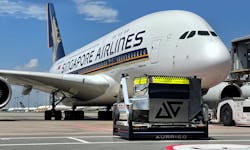Whether airport leaders are looking to overcome labor shortages, reduce the risk of airside collisions or enhance ground handling efficiency, officials at Aurrigo point to autonomous technology as the solution. And they are taking key steps to prove it.
The UK-based company has been working with officials at Singapore Changi Airport (SIN) to trial and develop its autonomous Auto-Dolly and Auto-DollyTug electric ground support equipment (eGSE) since 2022.
The Auto-Dolly and Auto-DollyTug are driverless vehicles designed to transport baggage. The units pick up ULDs filled with bags and autonomously drive them to and from the terminal and the aircraft. They can maneuver airside roadways on their own and are equipped with safety features that allow them to detect obstacles, ground support equipment and personnel.
The multi-year partnership between Aurrigo and the Changi Airport Group (CAG), which is poised to advance to its next phase, is designed to demonstrate autonomous technology’s value to the ground handling industry and showcase its possibilities to other airport stakeholders.
“If you take how we currently work on the apron – in other words the sequence of vehicles and the people that turn an aircraft around, whether it's baggage or catering or fluids or waste or whatever it is – that roster and how those vehicles approach the aircraft in what order, and also where they can go on the apron, really hasn't changed a lot,” says David Keene, CEO at Aurrigo.
“Part of this is all about drawing up the new blueprint,” he adds. “New, automated vehicles also bring the opportunity to bring in new processes.”
In addition to eliminating emissions by utilizing an electric drivetrain, Aurrigo’s autonomous vehicles offer several other benefits, according to Keene.
Top of mind for many ground service providers is overcoming labor shortages. By deploying autonomous vehicles, fewer people are needed for small simplistic tasks and personnel can be reassigned to high priority duties.
“Similar to major airports throughout the world, recruiting enough ground handling personnel and drivers to support our growth is a challenge,” Poh Li San, SVP of Terminal 5 planning with CAG said in a press release announcing the entities’ partnership. “We have been encouraged by Aurrigo’s innovative autonomous technologies to help address these issues, and we’re excited to partner with Aurrigo in joint development and testing of these solutions in the real world.”
“You may not need as many people, but you still need people. And the thing about the people that you need is they can be upskilled from the people that are already there,” Keene adds.
Aurrigo’s autonomous vehicles have collision-avoidance technology built in to safely maneuver around aircraft, GSE and people. Aurrigo’s vehicles can also operate in all weather conditions, including during storms when it’s unsafe for personnel to be on the ramp.
“You can run the vehicles when people can't,” Keene notes. “So, in that lightning condition, that's a really big benefit that really wasn't there to start with.
“We're in this mad new world of trying to solve all of these things,” he adds. “That's really what's taking up the time at Singapore and making sure that we can safely operate, we've got the right communication structures, we're working out how we service the aircraft, and new things are coming to the fore.”
A Partnership Focused on Innovation
Keene applauds CAG for being a partner on this project, noting the airport is a key driver behind the adoption of new technology.
“They're leading the charge on making changes to improve not just ground handling but also passenger experience and all the other types of things,” he says.
Keene recalls connecting with leadership from Changi in 2019. Aurrigo had won a Best Technology Award from Heathrow and was showcasing its technology at an exhibition in Singapore. Key officials with Changi’s Terminal 5 planning met with Aurrigo representatives at the event, and a partnership was formed.
“The team at Changi are superb. They're very focused on getting the technology to work. They're very focused on making sure it's safe just like we are,” Keene notes.
Together CAG and Aurrigo have worked step-by-step to understand the technology’s viability.
“To just get the vehicle airside, we had to pass something in the region of 380-odd tests, that were first of all working with the Civil Aviation Authority and CAG,” Keene recalls. “The first thing we did was to take our product Auto-Sim and we built in the airport environment.”Using Auto-Sim, a software solution for the simulation of airside vehicle operations, vehicles were tested at different points around the airfield.
“And we proved in simulation that, actually, we can make sure that we have a safe operation in all of those 380 different tests,” he says.
In the next phase, Aurrigo trialed its vehicles in a parking lot at Changi. This step built trust in the technology, so that the vehicles could be moved into the airside environment. More tests were conducted in the baggage hall, airside roadways and at a specially allocated aircraft stand with a test plane.
The final piece to the initial phases was interacting with a live aircraft.
“And that really is a stage where that has proved to Changi – and obviously a number of other people who have come to Changi Airport to look at what we're doing – that has proved an end-to-end operation of one vehicle can pick up a ULD in a baggage hold, take it out, take it in the roadways, go onto the apron, dock with the equipment, automatically unload it and then if necessary, do the reverse,” Keene says. “And that's a major, major step.
“So that has almost now taken us to the end of Phase 2A.”
What’s Next?
According to Keene, many improvements have been made to the latest version of Aurrigo’s autonomous vehicles. For example, the Auto-DollyTug now has electric autonomous arms that can grab a ULD or move a ULD off a platform, allowing for automated loading and unloading of a ULD.
“Even with the upgrades, we're really improving that vehicle all the time to the point at which we need to move to a new vehicle,” Keene says, noting the next generation vehicle will incorporate all of the learning that’s been acquired to date, plus more advanced features that company officials are still working on, such as fully variable deck height positioning.
Keene anticipates these new model vehicles will be able to perform their jobs properly with limited supervision.
“We've got about a year further of more vehicles going out and making sure that fleets of vehicles can work with each other and turn around live aircraft. And so somewhere this time next year, or maybe even a little bit sooner, I think you'll start to see the first real implementation into Changi Airport,” he says.
Phase 2B of Aurrigo and Changi’s partnership is intended to increase the number of vehicles performing autonomous services on the ramp.
“One vehicle won't do what we need to do to turn around a live aircraft. We need to do it with four or five vehicles, all working together in a synchronized way and connected somehow so that we know we're carrying the right ULD, we're delivering it to the right aircraft, we're depositing it correctly or we are picking up and doing the reverse,” Keene says.
Aurrigo and Changi’s goal is to service a live flight fully, taking all the ULDs off and on the aircraft and transferring them to correct locations.
“And, as you can imagine, that's quite complicated because that brings in multi vehicles, brings in connection into airport systems and it brings in connection into 5G secure networks so that we can make sure that we've got the cyber resilience as well of running those vehicles,” Keene says. “Once we've got through that, that really shows that you can do one aircraft on one gate with those number of vehicles.
“Why don't we do two gates, three gates, six gates, 10 gates, 20 gates and so forth?” he continues. “That's the master plan anyway.”
About the Author
Josh Smith
Editor
Josh Smith served as editor of Ground Support Worldwide as editor from 2016 through 2024. He oversaw production of the print magazine, created GSW's newsletters on a daily basis, and updated the latest news on AviationPros.com.

